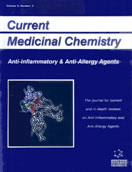Abstract
Allergic disorders are characterized by typical symptoms and an infiltrate of cells, including Th2 lymphocytes, eosinophils and mast cells. Activated mast cell mediators cause the early appearance of symptoms, and cytokines induce a cascade of inflammatory events. Both resident and infiltrating cells are important sources of those mediators and cytokines which maintain and enhance the allergic inflammatory response. The predominant preformed mediator released by mast cells and basophils is histamine, which binds to specific cell receptors to produce its clinical effects. Therapeutic intervention in allergic disease has thus commonly focused on blocking the action of histamine. Ever since Arunlakshana demonstrated, in 1953, the ability of antihistamines to inhibit histamine release by mast cells, numerous studies have been conducted, both in vivo and in vitro , to determine the H1 antihistamines additional properties which contribute to their clinical efficacy in the treatment of allergic disease. It has been reported that some antihistamines can also regulate the expression and / or release of cytokines, chemokines, adhesion molecules, and or / inflammatory mediators. Such properties make these agents important tools for the continuous longterm regulation of both early and late-phase allergic reactions. It appears likely that antihistamines exert these antiinflammatory effects by means of both receptor-dependent and receptor-independent mechanisms. The receptordependent mechanisms seem to involve inhibition of the generation of NF-kB dependent cytokines and adhesion proteins. The latter mechanisms, which require higher drug concentrations, appear to include the release by inflammatory cells of pre-formed mediators, such as histamine and eosinophil proteins as well as eicosanoid generation and oxygen free radicals production. Herein, we review the current state of knowledge of the anti-inflammatory properties of antihistamines and their mechanisms.
Keywords: anti-inflammatory effects, antihistamines, histamine, urticaria
 14
14

